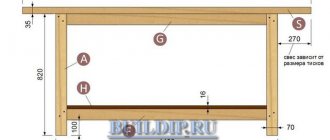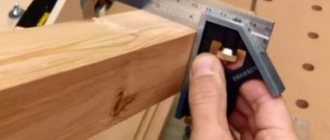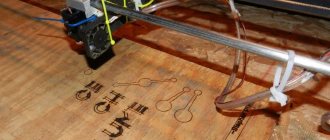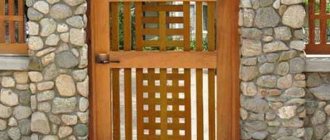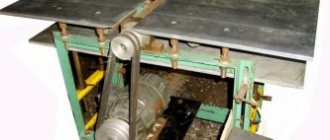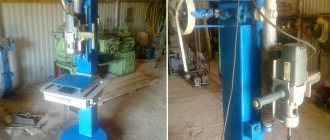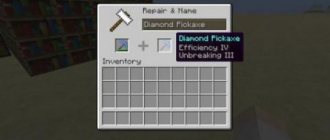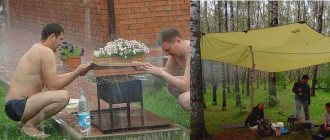From compressed air |
23.07.2017
The need for effective surface cleaning of various products before painting them suggests the idea of purchasing or making your own sandblasting chamber. These devices, varying in size and purpose, will be quite appropriate both in car service stations and in the home.
Types of cameras
The sandblasting chamber can be local or volumetric (inhabited). Local chambers are designed for processing small products. Habitable chambers have a large internal volume, where you can place, for example, the body of a car. When working, the operator is inside such a chamber, so he will need a set of certain protective accessories - a helmet, glasses, gloves for sandblasting, etc. However, it is also possible to remotely control the process of such cleaning (more on this later).
In local chambers, sandblasting is performed by creating reduced air pressure inside the working space. Under conditions of such artificial rarefaction, due to the pressure difference, a sand jet is ejected from the nozzle with the required speed and pressure. By moving the nozzle tip along a certain trajectory, the operator processes the surface of the workpiece. Naturally, in such ejection chambers it is easy to clean small products.
Advantages of local cameras:
- Compactness.
- Low financial and material costs for self-production.
- Increased safety for workers and the environment.
- Reduced energy costs since low suction compressor power is required.
- Convenience and ease of sand regeneration for reuse.
Inhabited cameras solve larger problems. Their volume must be very accurately calculated in order not only to freely position the object being cleaned inside and provide places for the worker to move, but also to ensure the necessary air exchange. Residential type sandblasting chambers operate on the principle of pumping a working mixture, and are therefore called pressure chambers. Their performance is many times higher than that of ejector-type cameras. Accordingly, energy costs also increase (a much more powerful compressor is required), sand consumption and sand losses increase. Another problem is the disposal of sand contaminated with cleaning products, which, in turn, requires the presence of effective filter systems.
This is interesting: Clutch check valve: design features and scope of application
How the camera works
Schematically, the sandblasting chamber looks like this:
Such a chamber is called inhabited because the process is controlled by a specialist who is located outside of it.
Despite the fact that modern components allow you to assemble the safest camera possible with your own hands, you should still use personal protective equipment when working:
- gloves;
- fully covered work clothes;
- respirator.
Please note that you can make such a camera of almost any size - from a small hangar to an entire garage. It all depends on what type of processing this equipment is intended to be used for.
- the ability to process surfaces of any size and shape;
- The cleaning process can even be controlled visually.
In fact, a correctly assembled model of such a unit makes it universal.
Recommendations for making a sandblasting chamber
Before you start creating a camera with your own hands, you need to develop its design and draw up a drawing. This will allow you to clarify the dimensions, purchase and measure materials correctly. The internal parameters of the device should not be made too large to avoid the effect of strong rebound and additional impacts of the abrasive on the product. If the chamber is still large, it is worth lining its walls from the inside with soft material, for example, rubber. Other tips for creating a sandblasting booth include:
- it is necessary to pay close attention to the quality of ventilation of the installation;
- to install the viewing window, it is advisable to purchase impact-resistant plastic, since simple glass will break quite quickly;
- It is recommended to lay a reinforced mesh at the bottom of the chamber, and place a strong chute under it for waste abrasive;
- To place any products in the chamber, including those with a non-standard shape, the sides should be covered with a tarpaulin and not made rigid.
What can sandblasting be made from?
To understand how easy it is to make sandblasting with your own hands, it is enough to dwell on the operating features of each structural unit. In this case, the selection of available parts or finished products becomes obvious.
- Mixing unit. Sand for sandblasting and compressed air from the compressor come here from two hoses. The output is a ready-made air-abrasive mixture. In this case, no requirements, for example, the volume of the mixing chamber, are imposed on the unit. On this basis, you can use a regular plumbing tee to make it.
- Control devices. A normal manual sandblaster should be able to adjust the air flow and the intensity of the abrasive material. In this case, no requirements are imposed on the control device. At home, this role is well performed by water ball valves made of steel.
- Connection points. To connect the hoses, conventional fittings are installed on the portable sandblasting machine. They can be equipped with clamps for secure fastening. All these components are easy to buy in stores.
- Receiver. This part of the design is needed to facilitate the operation of the compressor and stabilize the pressure. You will definitely need a receiver if you want to get a powerful sandblast with your own hands. This device can be made from a powder type fire extinguisher with a large housing capacity. Another option is to make a receiver from a gas cylinder.
- Abrasive chamber. The components for its manufacture may differ depending on the type of installation being created. For example, an ejector-type mini sandblasting machine is assembled with a plastic bottle for abrasive. A pressure installation will require a durable container made from a fire extinguisher or a freon cylinder.
Important! The connection diagram for moisture separation and oil collection devices depends on the specific product purchased for this purpose. However, most of the models on the market will only require the manufacture of an outlet from a plumbing tee onto which the hose fittings are mounted.
Algorithm and assembly rules
A sandblasting chamber - both industrial and self-assembled for home use - must be equipped with a ventilation system that will ensure the removal of dust generated in large quantities during processing. As mentioned above, when working with such a camera, no matter how well it is made, it is necessary to use eye, respiratory and entire body protection.
The structural elements that you will need to make a sandblasting machine used in conjunction with such a camera are:
- a container for abrasive material from which it will be supplied to the processing zone;
- a compressor that provides the necessary pressure of the air flow mixed in the system with abrasive;
- a nozzle through the internal hole of which the abrasive mixture will be supplied to the processing zone;
- gun for controlling the nozzle and making it easier to work with;
- a ball-type valve that will allow you to adjust the flow parameters of the abrasive mixture;
- elements that ensure fastening of all structural parts and their sealing.
Interior of the chamber with the side door open
To make the sandblasting chamber stable, you can place it on a work table or make a special stand for it from a metal profile. For the inner walls of the sandblasting chamber, it is better to use sheet metal whose thickness does not exceed 1 mm.
In order to be able to constantly monitor the sandblasting process and effectively manage it, it is necessary to make an observation window on one side of such a chamber, and organize a lighting system in its inner part. It is better to use impact-resistant plastic as the material for making such a window (ordinary glass may not withstand significant loads and quickly fail).
To control the sandblasting nozzle, which will be located inside the chamber, two symmetrically located holes must be made in the front of the latter. The diameter of such holes in which work gloves will be fixed should be approximately 100 mm. It is necessary to take into account the fact that the work gloves located inside the chamber will quickly become unusable, so it is necessary to ensure that they can be quickly and easily replaced with new ones.
Transition cuffs - an easy way to quickly change work gloves
A chute should be placed under the bottom of the sandblasting chamber, with the help of which the waste material will be collected in a special container, so it is best to use durable mesh material to make the bottom. The collection of waste abrasive material, if done carefully, will allow it to be reused, which will significantly reduce the cost of processing. To effectively illuminate the interior of the sandblasting chamber, it is best to use two lighting fixtures located at two different edges of its upper part.
Abrasive material collection hopper (bottom view)
The sandblasting nozzle, with which the treatment is carried out inside the chamber, is located in its internal part, and its connection to the container with sand and the compressor is ensured using special hoses. You can hang a large door on the back wall of a homemade sandblasting chamber (you can also cover the wall with a tarpaulin), which will allow you to easily place products of various sizes and configurations into it.
When starting to assemble a sandblasting chamber with your own hands, you should take into account that only high-quality structural elements, as well as strict adherence to the recommendations of experienced specialists and a previously developed drawing, can ensure the durability and high efficiency of using such a design.
How to choose an abrasive
Initially, there was no such choice at all in sandblasting. We worked with ordinary quartz sand. This is the cheapest and most accessible material. At this time, abrasives with completely different properties can be used.
In some European countries, the use of ordinary sand is already prohibited, since the dust that appears as a result of processing can greatly harm those nearby.
Despite its negative consequences, quartz sand is still the most common. There are several reasons for this: the low cost of the material, the ability to be reused, for example, for construction purposes, and ordinary sand is considered an abrasive of medium hardness, which allows a person with insufficient work experience not to be afraid of damaging the surface. How to make sandblasting work correctly with your own hands? It is important to select sand of the required fraction. Quartz sand has at least three of them: river (the largest), sea (some do not recommend using it, since the presence of salt can cause corrosion; degreasing does not help, you need to wash the sand in advance) and quarry sand. Thanks to this, you can choose your own fraction for each surface.
What other types of abrasives are there:
- Cooper slag or nickel - this waste product from copper or nickel production is characterized by high hardness and strength.
- Garnet sand is a special type of sand used in high-power sandblasting machines for cutting metal.
- Electrocorundum or aluminum oxide is the hardest known and available abrasive. Can be reused many times since the particles do not break down or lose their shape during processing.
- Steel or cast iron shot is an expensive material, but has great advantages. It has the property of hardening the surface like forging.
What should you consider when selecting an abrasive? It all depends on the work being performed. For example, you need to remove paint from the façade of a house. The volume is large, the material being cleaned is soft. Cheap quartz sand will do. Used sand can be reused, for example in concreting or brickwork.
Drawings with dimensions
When assembling the sandblasting chamber, you must adhere to the dimensions indicated in the drawing.
This is interesting: Welding inverters "Resanta": we understand the devices of a famous brand
Alternative manufacturing methods
The many options for homemade sandblasting are determined by the needs of the owners and the different materials available. You can make your own effective installation using products intended for other work. For example, a high-pressure washer unit will help you assemble a dust-free sandblasting machine with your own hands. Below are several working and effective options for homemade installations.
From a pressure washer
You can assemble a sandblaster from Karcher. This car wash creates high water pressure with low water flow. To obtain an efficiently operating dust-free installation, you just need to assemble a special nozzle for the outlet tube. Required:
- a self-made or store-bought ceramic nozzle;
- reinforced hose;
- mixing block, a tee with a suitable fit diameter is suitable;
- feed adjustment unit, cylindrical type dispenser;
- a tube for collecting abrasive, equipped with an air supply path into a closed container with sand or other material.
Water sandblasting from Karcher operates on an ejector circuit. High-pressure water passing through the mixing unit at high speed creates a vacuum in the abrasive supply path. Sand flows in and out with high pressure fluid.
The water sandblaster of this design has some features.
- The flow intensity is high with low water flow. This allows the installation to be used for glass, frosting or other processing.
- For stable feeding, an abrasive of uniform dispersion and small fraction must be used. For domestic use, fine, sifted river sand is suitable.
From a blow gun
Small and efficient - this is how sandblasting from a blow gun can be described. This device will allow you to carry out, for example, body work with fairly high efficiency. However, the performance depends entirely on the compressor used. To assemble the device you will need:
- ready-made pneumatic blow gun;
- plumbing tee;
- ball valve for adjusting the abrasive supply;
- outlet nozzle with clamping nut.
The design is not complicated. How to assemble it can be seen in the next photo.
Either a lightweight powder fire extinguisher bottle or a plastic bottle can be used as a container for abrasive.
Using a spray gun
You can create a homemade sandblast using a spray gun. For this you will need:
- mixing valve from a conventional spray gun;
- handle with air supply mechanism for the spray gun;
- bottle for abrasive mixture:
- tee;
- ball valve regulator.
The operation diagram of the finished device is as follows:
To assemble the structure you will need:
- sharpen the spray gun to use a nozzle of the required dimensions;
- attach the mixing tee to the gun;
- install and secure the supply and circulation hoses.
Important! The supply of sand or other abrasive from the container is started by simply pressing the trigger. The volume of the bottle is enough to treat small parts or surfaces for 20-30 minutes.
How to make a camera with your own hands
A small stationary camera will not take up much space; it can be stored and used in a garage or shed. Essentially, it is a box made of metal or other material, lined with metal more than 1 mm thick. It is best to place the finished camera on a table or other stand - this way it will be comfortable to work with it.
Work zone
The working area is the inner part of the chamber, closed during cleaning, into which the product is placed. There must be a mesh or grate on the floor of this area so that sand does not linger inside and fall through the bottom. The device must be equipped with a viewing window through which the operator can observe the process and evaluate the results.
Good lighting is planned at the top of the working area so that there are no dark areas left. The lamps must be closed, otherwise dust and sand will quickly damage all contacts. Inside the housing there are gloves attached with a clamp on the flange, as well as a sandblasting sleeve with a nozzle (in the pressure chamber) or a gun (in the injection chamber).
Cone bottom
The bottom must be large, otherwise the workings with abrasive will not be able to fit and will begin to layer and accumulate in slides. To easily remove waste, you need to provide unobstructed access to the bottom (it is most convenient to pour abrasive and dust into a regular bucket). If the chamber assumes the possibility of returning the mass, and its collection is carried out automatically, the bottom walls should be sloping.
Hood
The hood creates a vacuum of air and removes dust from the sandblasting chamber. It must be equipped, because part of the sand or other abrasive material, after hitting the surface of the product, is destroyed and turns into flying dust. To equip the hood, it is recommended to use an electric motor with a power of 0.3–0.75 kW with a bladed propeller.
Sandblasting machine
The basis of the entire system is the sandblasting unit itself, which processes various surfaces. The most common are injection guns that operate on a simple principle: compressed air is supplied separately from sand, and the latter flows by gravity from a separate container through its own hose. Typically, such devices are used to treat delicate surfaces - removing small dirt, frosting glass. The injection device will also remove a thick layer of paint and rust, but 3-4 times slower than a pressure device.
Pressure-type sandblasting machines have an air line divided into two parts: one goes into the container with abrasive, the second goes to the exit from it. After the sand is released under pressure, it is connected to a stream of compressed gas, and the acceleration of the particles will be maximum. With this processing, the speed of action is an order of magnitude higher.
General building
This section of the sandblasting installation connects the attachment parts, device control, and electrics. The holes for the arms should be located at a height convenient for the operator, and the distance between them should also be optimal. The most comfortable hole diameter is considered to be 10–12 cm, and this is the size of gloves that should be selected.
Sandblasting gloves must be strong and dense, because they will protect your hands from ricochet. To fasten them, it is better to choose flanges, which, after putting on gloves, are clamped with clamps. At the top of the common body there is an air damper through which clean air will flow.
Lighting
The lamps should illuminate the work area evenly so that all areas of the workpiece are clearly visible to the operator. To protect the lamps from impacts and dust, they are covered with a plastic casing on top, and to maintain transparency, a fine-mesh mesh is placed on the outside (the same device should be attached to the viewing window). Usually, two light bulbs are enough for high-quality lighting for an average-sized camera.
What to make a nozzle and gun from
A homemade sandblasting gun is also not difficult. It can be made using a nozzle on a ball water valve installed at the end of the air-abrasive mixture supply hose. This output element is a clamping nut that secures the nozzle for ejecting the abrasive.
The last structural element - the nozzle - can be made of metal by turning the part on a lathe. However, it makes more sense to make the nozzle from a spark plug. To do this, the old part is cut with a grinder, separating the durable ceramic pillar from the metal structural elements and forming a suitable length.
Important! The process of separating the desired part of the candle inevitably results in the formation of a huge amount of dust and an unpleasant odor. Therefore, if you do not have the skills to work with an angle grinder and a workshop, it is recommended to buy a ceramic nozzle in a store.
It is worth especially noting: homemade designs often show better results than a ready-made sandblasting gun, many models of which are presented in retail sales. Therefore, it is wise to spend time creating your own solution, which does not require significant financial investments.
How does a sandblasting machine work?
The design and layout of the sandblasting device is quite simple. The device consists of the following parts:
- a tank for sand or other abrasive mixture;
- neck through which the material is poured into the tank;
- a hose for supplying a mixture of sand and air under pressure;
- compressor;
- pressure gauge for monitoring pressure;
- nozzle through which the abrasive mixture is discharged.
Most models of sandblasting machines are equipped with wheels and handles for moving the device around the site. Also, the units usually have a support leg, which gives them stability and partially dampens vibrations during operation.
What to look for when buying a camera
When choosing and developing your own sandblasting chamber, first of all, you need to check the compliance of the diameters and lengths of its hoses with the performance of the compressor. Other important factors to consider:
- Air Dryer. Moisture in the air-abrasive flow makes it uneven, because in this case the powder particles stick together into large fractions of different sizes.
- Reservoir capacity for working powder. In open systems, an operating time of at least 30–40 minutes must be ensured.
- Tank slope. It should be no more than 40º, otherwise the powder will not pour well into the dispenser.
- Calibrated sieve on the loading funnel. Helps remove various impurities and large particles. Particularly useful when reloading abrasive after use.
- Protective mesh in front of the camera viewing glass. With good lighting it does not interfere with work at all, while protecting the glass from rapid frosting.
- Ease of loading. The door must provide access to the entire interior of the cabinet.
- The presence of a sufficiently powerful hood and a large dust container.
The nozzles of pressure sandblasting machines provide greater productivity and ease of use, due to the fact that the air-abrasive mixture is supplied to them through one hose. However, such devices require compressors with high air flow rates.
Safety precautions
When using abrasive materials, safety precautions must be observed. You should work in a closed suit, and always with a respirator. Also pay attention to your shoes - they should be completely closed.
By following all the recommendations for arranging the camera and working with it, you can safely and efficiently process almost any surface.
Author: Baranov Vitaly Petrovich
Education: secondary specialized. Specialty: car mechanic. Professional diagnostics, repair, maintenance of passenger cars of foreign production 2000-2015. Extensive experience working with Japanese and German cars.
Algorithm for making sandblasting from a gas cylinder or fire extinguisher
The simplest sandblasting design that you can do yourself is a pressure-type installation . To make it you will need (the principles of selection and purpose of the components are described above):
- ball valves, 2 pcs;
- freon cylinder, gas or fire extinguisher;
- a piece of pipe to create a funnel for pouring abrasive into the chamber;
- tees, 2 pcs;
- hoses with internal diameters of 10 and 14 mm for releasing abrasive and supplying air from the compressor, respectively;
- fittings and clamps for fastening hoses;
- plumbing fum tape for connecting structural elements.
Sandblasting is produced according to the following algorithm.
- The camera is being prepared. To do this, gas is released from the fire extinguisher or powder is poured out, and the contents are removed from any cylinders under pressure.
- Holes are made in the cylinder. From above - for pouring abrasive (corresponding to the diameter of the selected tube), from below - for welding the tap.
- The tap for adjusting the supply of abrasive can be tightly welded into the cylinder. Another option is to pre-install an adapter onto which the regulator is screwed.
- After the tap, using fum tape, a tee and mixing unit are installed.
- A tap is mounted on the cylinder valve, followed by a tee.
The assembly of the main structure is completed by welding wheels or carrying handles. Support legs will also help so that the sandblaster is not only mobile, but also stable.
Next, connections are made and the formation of supply and exit paths for the finished working mixture is carried out:
- fittings are installed on the cylinder valve, lower tee;
- an air supply hose with a diameter of 14 mm is located between the valve tee and the corresponding mixing unit at the bottom of the cylinder;
- a compressor is connected to the remaining supply of the valve tee with a fitting;
- The working mixture supply hose is attached to the free outlet of the lower tee.
At this point, the creation of the device can be considered complete.
Advice! To ensure a tight seal, it is recommended to select a screw-on cap for the abrasive sand filling tube.
